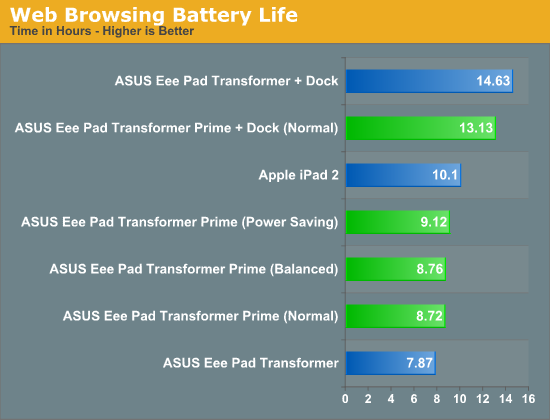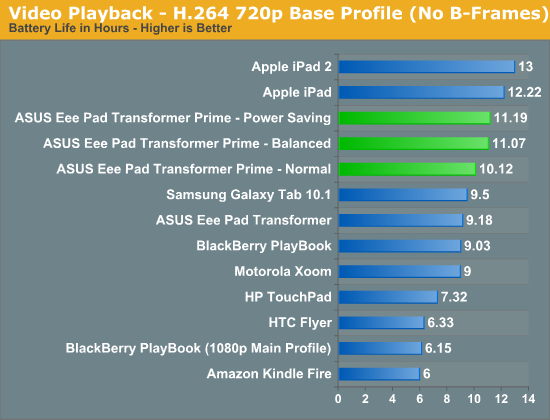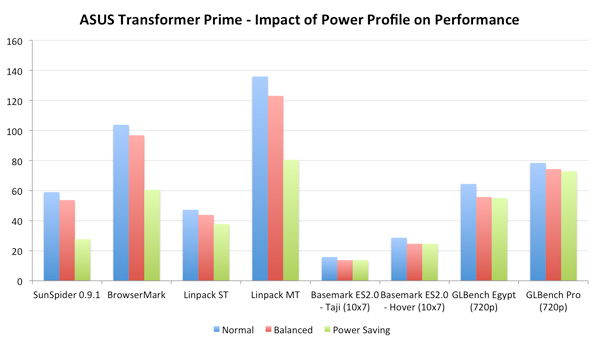ASUS Eee Pad Transformer Prime Review Part II: Battery Life & More
by Anand Lal Shimpi on December 15, 2011 3:45 AM ESTThe Final Word on Battery Life
In our iPhone 4S review I mentioned that our web browsing battery life tests were in dire need of an update. The move to iOS 5 increased the aggressiveness of browser side caching, which impacted our old tests significantly. We still have plans for a much more significant departure from our existing battery life testing methodology, however as an interim solution I developed a modified version of our traditional smartphone battery life test.
The old web browsing test lacked any significant cache busting features and the HTML workload itself was more representative of mobile sites than a full desktop experience. The modified test does a much better job of not allowing its components to be cached by the browser, and includes both lighter and full desktop websites. Since the workload has changed, these numbers are no longer comparable to those running the older version of our test. The new web browsing test is also stressful enough to span both smartphones and tablets, whereas before we had a separate version just for tablets.
Finally, I must mention that we ensure all tablets tested here are normalized to the same display brightness setting of 200 nits for a true apples to apples comparison. As always we rely on the stock web browser that ships with the platform and manually quit all background tasks before running our tests. In the case of the Transformer Prime, I was able to run our new battery life test using all three power profiles to get a better idea of the range of battery life. As a recap, here are the details on the power profiles.
ASUS and NVIDIA have defined three power profiles on the Prime: Normal, Balanced, and Power Saving. Normal allows the CPU to run at up to 1.4GHz with only a single core active, and 1.3GHz otherwise. Balanced is the default setting and it drops maximum CPU clock to 1.2GHz and favors lower clock/voltage targets on the curve compared to Normal mode. Power Saving caps CPU frequency at 1GHz with 1—2 cores active, 760MHz with 3 cores active and 620MHz with 4 cores active. It's unclear what the impact is on GPU clocks/performance. I've also noticed that the Power Saving profile also enables a dynamic contrast control that you can't override.

The shipping Prime does much better than the original tablet I reviewed a couple of weeks ago. It's clear that whatever was impacting WiFi performance also took its toll on battery life. What I suspected might be the case ended up being true: the implementation of Tegra 3 in the Transformer Prime delivers better battery life than Tegra 2 in the original Eee Pad Transformer. There are too many variables here for me to attribute the gains to NVIDIA's SoC alone, but seeing as how battery capacity hasn't changed it's likely that we do have Tegra 3 to thank for better battery life in the TF Prime.
Note that even running in Normal mode and allowing all four cores to run at up to 1.3GHz, Tegra 3 is able to post better battery life than Tegra 2. I suspect this is because NVIDIA is able to parallelize some of the web page loading process across all four cores, delivering similar performance to the original Transformer but at lower frequency/voltage settings across all of the cores. Additional performance gained by supporting NEON likely helps improve efficiency, not to mention higher single-threaded performance thanks to Tegra 3's higher clocks. Combine all of this with a more mature 40nm process and a more mature Cortex A9 implementation on that process, and the power improvements make sense.
The Transformer Prime is still unable to dethrone the iPad 2 here, which just goes to show you how efficient Apple's platform was to begin with. That being said, the Prime is within striking distance of Apple's tablet. The race is now close enough where you won't notice too much of a difference between the two.
There's also not a huge difference in battery life between the various power profiles. I do applaud ASUS and NVIDIA for giving us control over the CPU governor, but unless you're trying to make the tablet last over a very long flight you're probably fine just leaving it in Normal mode and enjoying the extra performance.
I included results from the Prime running with its dock attached. The additional 22Wh battery improved battery life by 51%. The scaling isn't linear because the dock itself draws power. Once the dock's battery is depleted, the tablet needs to power both itself and the dock. The improvement is tangible though, if you need to do a lot of writing on a flight around the world the dock will help you get there.
Video playback battery life is much better than the original Eee Pad Transformer. Tegra 2 was clearly broken when it came to its video decode abilities and as a result we saw significant limitations on both what video you could play and how long you could play them. Tegra 3 fixes all of that, and the result is battery life that's getting closer to the iPad 2:

Getting 11 hours of continuous video playback battery life is something to be proud of. Being able to watch 4-6 full length movies on a plane without worrying about your battery is a pretty nice feature. Unlike the active use case, video playback seems to see a bigger benefit from switching away from the Normal power profile.











58 Comments
View All Comments
kenyee - Thursday, December 15, 2011 - link
I'm not sure this would show up in the color gamut tests because the original Transformer had an 18-bit dithered screen...lordmetroid - Thursday, December 15, 2011 - link
Can I install whatever operating system I want?jllcmu04@hotmail.com - Thursday, December 15, 2011 - link
Hi,First off, I am very happy for your thoroughness. You always try your best in your reviews. My trouble is with your CONSTANT comparison to mac book air. How expensive is your mac book air, and what processor and hd etc come with it? Even if you take the 64 GB model TF-Prime, you are still easily a couple hundred under MBA. Also, as you mentioned, one is a tablet + dock , while the other is designed, albeit very very well, as a laptop. Now the comparison to netbooks is one I can understand, but the constant comparison to MBA I feel degrades from true evaluation. One thing I found funny, is that even with the comparison to a system that is much more expensive, it still is able to keep up some.
Anyway, thanks for a great review!
J
Graag - Thursday, December 15, 2011 - link
"Now the comparison to netbooks is one I can understand, but the constant comparison to MBA I feel degrades from true evaluation."I think that comparisons like this are actually very helpful, since there are a decent number of people who want to know whether they need a MBA/Ultrabook, or whether they can save $400-$500 and use a tablet. And, particularly because tablets are still pretty new (as mainstream devices, anyway), it's also useful to delineate the boundaries between laptops and tablets.
"One thing I found funny, is that even with the comparison to a system that is much more expensive, it still is able to keep up some."
This is a very important point for some users - and a point that wouldn't have been made but for comparing the tablet to a MBA.
DanNeely - Thursday, December 15, 2011 - link
There's not a major ultraportable laptop platform between netbooks and the mba. Some of the cheaper ultrabooks might drop into it but none are there in meaningful volumes yet.justaviking - Thursday, December 15, 2011 - link
I cannot get your video to load."An error has occured, please try again later."
vision33r - Thursday, December 15, 2011 - link
1.4GHZ Tegra 3 is barely faster than the iPad 2 and we know that thing only runs at 1GHZ.By March, we know the A6 will be quad-core and most likely run at 1.2GHZ and Apple always make a huge performance leap just to keep the device potent enough for a whole year.
Why would anyone want to buy the TF Prime that will be the fastest Android tab for about 3 month for $500
Samsung will have their own quad-core Exynos out soon too.
iPad 3 will also have a 200ppi display which will make every other tablet look like a pixel board.
This is not an Apple fan post, just stating the what the competition will be and Tegra 3 is a very small upgrade.
eddman - Thursday, December 15, 2011 - link
No, It should read "transformer prime is barely faster than the iPad 2".There is no way tegra 3 is slower than A5, it's the software. While ios is fully optimized for A5, honeycomb can't even utilize dual-core chips properly. Let's see what ICS would do.
Personally, I'm waiting for windows 8 tablets.
shady28 - Friday, December 23, 2011 - link
A lot of semantics there. True that A5 is probably slower than Tegra 3, but also from the article there is no significant performance difference between an iPad 2 vs Transformer Prime. The OS and platform do count.
I'm a bit disappointed too though. I really thought the quad core Tegra 3 would be at least 40% or so faster than similar clocked A9 based systems just because of the extra 2 processors, but apparently not. I'm thinking maybe Android isn't quite optimized for more than 2 cores yet.
IntelUser2000 - Thursday, December 15, 2011 - link
"Whereas the move from one to two cores was instantly noticeable on Android phones, the move from two to four is understandably less appreciable."It looks like 4 core is for the forseeable future a practical limit for the "multi-core" era before we opt for another approach.
The gains in battery life in web browsing and video playback is likely not due to having extra cores and being able to clock them down faster, but the more advanced power saving available in Tegra 3.
They noted something similar to Intel's DPST(Display Power Saving Technology), along with better C states compared to Tegra 2.